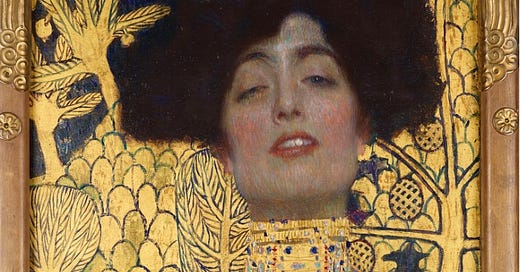The Muse & The Motive: Gustav Klimt and Adele Bloch-Bauer
On Gustav Klimt's "Judith and the Head of Holofernes" (1901) and art nouveau's objectification of women.
Gustav Klimt’s sensual portrayal of Adele Bloch-Bauer in Judith and the Head of Holofernes (1901) demonstrates how women in Art Nouveau portraiture were subjected to the movement’s legacy of the provocative, seductive and beautiful objectifying their portrayals. Emerging roughly between 1890 to 1910, Art Nouveau’s conceptualization of the anxieties fueled by the changes of a rapidly modernizing society championed an avant-garde movement that sought to balance the rational and spiritual ideals of the era.
The international movement, coined in 1895 by Seigfried Bing, a German art dealer living in Paris, after his shop, Maison de l’Art Nouveau, drew inspiration from an amalgamation of rococo, gothic, Japonisme and Arts and Crafts elements, and is remembered for its aversion towards the conventional styles that constituted ‘fine art’.
Henceforth, Klimt artistically embodied the movement’s ethos of radical change through their sensual portrayals of women pioneering the notion of the femme fatale—a seductive woman of aspirational beauty who harbours a dangerous, erotic allure.
Hailing from Vienna, Gustav Klimt was an artistic visionary of the Art Nouveau movement. As a prior leader of the Secessionist art movement, his Art Nouveau works built upon the Secessionist’s anti-academic classicism rhetoric by favouring artwork that embraced rich abstraction, ornamentation, and, most importantly, erotic portrayals of women.
Adele Bloch-Bauer was a respectable Viennese socialite in the nineteenth-century. Married to a banker, and coming from wealth herself, Bloch-Bauer possessed a refined sensibility. Becoming a patron of the arts and mingling with artists to quell the void of being denied a university education because of her sex, she became acquainted with Klimt towards the end of the nineteenth-century, and revered him for pioneering such a radical approach to art. She epitomized the contemporary Viennese woman: intellectual and sophisticated with an affinity for progressive change. Thus, casting Bloch-Bauer as Judith in Judith (1901) is reflective of Vienna’s disquietude atmosphere, for the novel intellectual and artistic changes prevalent in the city at the turn of the twentieth-century provoked Klimt to portray the femme fatale at the center of his work.
Klimt’s Judith and the Head of Holofernes (1901) is his version of the biblical story made during his renowned gold period. A determined, ruthless heroine, Judith’s legacy as the woman who seduced and killed the general Holofernes to save her Assyrian town has evolved from being a venerated symbol of bravery into an example of the dangerous powers associated with women. Her sexually allusive narrative naturally nominated her to be a historic example of a femme fatale, and made her an inspirational muse to Klimt. Klimt’s version deviates from the biblical story by evidently omitting details like her sword to ensure that the focus is on Judith’s—Bloch-Bauer’s—erotic portrayal.

An oil-on-canvas painting, Bloch-Bauer’s presence acquires the majority of the canvas, with only a sliver of Holofernes’ head visible in the lower right-hand corner. Despite the painting’s perceived flatness, Bloch-Bauer’s forward-facing figure stands out against the decadent, golden Byzantine-inspired mosaic behind her, where the roughly sketched fig trees and hills are hypothesized to pay homage to relief sculptures from an Assyrian palace in Nineveh where the biblical story originates.
The vibrancy of the gold emphasized by the dark blue and purple hues apparent in her clothes and the background create a vaguely alluring atmosphere: the mystic composition entrances the audience, but distracts them with the shimmering gold symbols adorning her clothes and the background, ultimately mirroring the way the audience gets distracted by Bloch-Bauer’s sexuality and disregards the depiction her heinous crime. Bloch-Bauer’s heavy eyelids, rosy cheeks and parted lips allude to an orgasmic aura, as her gaze just barely meets the audience’s and exudes a sense of seduction.
The slight upwards tilt of her head may additionally allude to a sense of pride—or even confidence—she feels from committing this violent act. Contributing to this sexually charged composition are her exposed breasts painted at eye-level making the audience confront this erotic spectacle head-on. Her breasts are further emphasised by the way her naturalistic depiction contrasts the geometric, golden details surrounding the milky-white expanse of her torso. A sheer, tunic-like top loosely draped over her shoulders fails to conceal her breasts; a thick, gold necklace embedded with a variety of jewels promotes the impression that she, like the ornate luxury encompassing her, is an object of desire.
Bloch-Bauer’s captivating sexuality is all consuming and distracting: as the audience fixates on her, they pay little attention to Holofernes’ severed head dangling flaccidly from her claw-like grasp. Thus, manipulating Bloch-Bauer’s identity into the portrayal of this historically seductive heroine symbolically reinforces the era’s discourse of the sensual, beautiful, man-killing woman.
The modernising gender hierarchy unearthed at the dawn of the twentieth-century sparked backlash amongst men and conservative women alike who desired to keep men and women as opposites rather than equals. The affinity to retain the gendered social order into the twentieth centuries inspired Klimt to convey the dangers of the contemporary woman as a castrating female by portraying them in an idealised, overtly sexualised manner.
Depicting Bloch-Bauer in an eroticised manner exemplifies how Klimt’s exploitation of her sexuality is one way he exercised power over Bloch-Bauer’s portrayal, and thus perception. By reducing this beloved socialite down to her sexuality, he essentially undermines the newfound freedom of female sexuality that she, a modern Viennese woman, supports.
Henceforth, Klimt’s conscious depiction of Bloch-Bauer in may be interpreted as a pointed mode of rebellion against the anxiety surrounding women’s newfound social mobility at the turn of the twentieth-century. With this in mind, we can understand Klimt’s Judith (1901) to be a medley of his fears and vision.
all words are my own, this post was adapted from my Art History final paper :)






